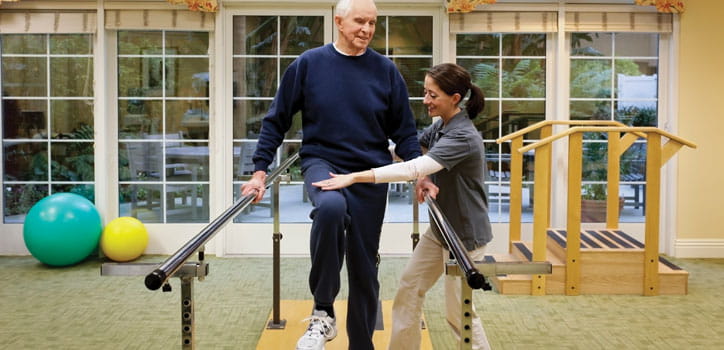What therapies does skilled nursing offer?
The therapies a patient receives in skilled nursing depend on why they’ve entered the facility and how serious their needs are.
Some of the treatments offered in skilled nursing facilities may sound similar to those offered in rehabilitation facilities and even assisted living, and there is some overlap.
But in general, rehab is more intensive and shorter-term than skilled nursing. And skilled nursing offers more specialized medical care than assisted living does, though both offer help with activities of daily living.
A senior’s personalized care plan will include a combination of many different treatment types, including the ones we’ll describe in the sections to come.

- Walking
- Transferring, including from bed to a chair, or into a wheelchair or walker
- Feeding
- Dressing
- Grooming
- Bathing
- Toileting
The main difference between skilled nursing and assisted living: assisted living is a long-term residential move. Skilled nursing may be shorter-term, but skilled nursing caregivers can still assist with ADLs as needed — likely in tandem with physical or occupational therapies — while patients work to regain their independence as much as possible.
In skilled nursing, physical therapy helps patients maintain and build physical function as they age, or regain what they lost because of an injury, illness or surgical procedure.
Physical therapists might perform hands-on manipulation of muscles and joints or supervise exercises to help a patient to reduce pain and inflammation levels, build strength and increase range of motion.

Speech-language therapists in skilled nursing work with a variety of patients, including those with dementia, patients who have suffered a stroke and those who have developed swallowing disorders (also known as dysphagia).
Speech therapists can devise treatments that address cognition, memory, speech and even eating and swallowing.

The main role of an occupational therapist is to help patients regain or improve their ability to perform activities of daily living (ADLs) — and, by extension, regain or improve their sense of independence.
They can help seniors adjust to new physical and cognitive realities of aging and any conditions that led them to seek skilled nursing care. This may also include suggestions for how to adapt a patient’s home environment and make ADLs more accessible.
For patients recovering from an injury or surgery, skilled nursing caregivers can monitor and dress wounds or incisions and administer antibiotics to prevent infection.
Patients living with chronic wounds, including ulcers, may need more specialized care, and some facilities offer advanced treatments such as hyperbaric oxygen therapy and more.
As seniors age and their healthcare needs change, they may require a variety of prescriptions to manage both chronic and acute health concerns.
When managing those medications’ dosage, timing and even administration become more complex than a senior or an at-home caregiver can handle, skilled nursing is an option.

Skilled nursing caregivers can ensure their patients take the right amount of their medications at the right time, whether orally, intravenously or via a catheter. They can also monitor for side effects and ensure they’re tolerating the medication well.
Patients in skilled nursing may also need help ensuring they get the fluids and nutrients they need to remain healthy and be as successful as possible throughout the other treatments they’re receiving.
Skilled nursing caregivers will monitor the food and water patients are taking in if they’re eating and drinking independently. They can also ensure that intravenous hydration systems and feeding tubes are properly inserted and maintained.
Skilled nursing therapies aren’t on everyone’s minds when they begin thinking about senior living.
But if you’re planning ahead and want to keep enjoying retirement and secure access to future care, should you need it, Continuing Care Retirement Communities (or CCRCs) could fit the bill.
In CCRCs, skilled nursing is just one part of the full continuum of care. Residents can easily transition — often with little to no increase in their monthly costs, beyond certain ancillary expenses — from independent living to a care center with assisted living, skilled nursing and memory care.

Glad to be connected!
There’s a lot to consider when embarking on the next phase of retirement—and contacting us is a big step. (Well done!)
We’ll be in touch soon to share expert insights and resident perspectives that we hope are helpful, and one of our team members will also be reaching out to answer any questions you may have.
